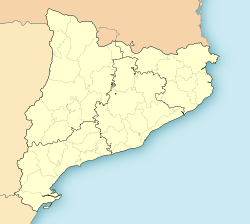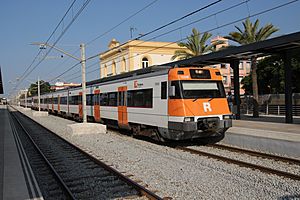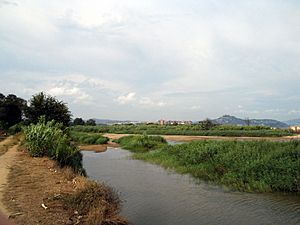Malgrat de Mar facts for kids
Quick facts for kids
Malgrat
|
||
|---|---|---|
|
Municipality
|
||
| Malgrat de Mar | ||

Malgrat de Mar in 1999
|
||
|
||
| Motto(s):
Malgrat t'estima*
|
||
| Country | ||
| Community | ||
| Province | Barcelona | |
| Comarca | Maresme | |
| Area | ||
| • Total | 8.8 km2 (3.4 sq mi) | |
| Elevation | 4 m (13 ft) | |
| Population
(2018)
|
||
| • Total | 18,439 | |
| • Density | 2,095/km2 (5,427/sq mi) | |
| Demonym(s) | Malgratenc | |
| Area code(s) | +34 93 | |
Malgrat de Mar is a town in Catalonia, Spain. It is located on the Barcelona Coast. You can find it between the towns of Santa Susanna and Blanes.
Malgrat de Mar is part of the Maresme area in the province of Barcelona. A local road connects it to the main N-II road. Another road, the B-682, links it to nearby towns like Blanes and Lloret de Mar. The town also has a train station. It is on the R1 line, which goes between Barcelona and Maçanet-Massanes.
Contents
A Look at Malgrat de Mar's History
Malgrat de Mar was once part of the Palafolls area. The very first houses were built by fishermen. They were near a small chapel called Sant Antoni Abat.
Early Days and Challenges
In 1373, the town was officially founded. It was first known as Vilanova de Palafolls. During the 1500s, the town faced attacks. The Ottomans attacked it in 1543, 1545, and 1550. In 1559, Malgrat became its own parish, separate from Sant Genís de Palafolls.
Since the 1300s, Malgrat de Mar has been important. It became a center for culture, art, and social life. Later, the Modernist art style also left its mark on the town.
Where Does the Name Come From?
The name "Malgrat" appeared in the 1800s. However, the place was known by this name even in the 1200s. People disagree about where the name comes from. Some think it's a very old, pre-Roman word. Others believe it means "bad landing place" (mal grau).
One interesting idea comes from a story. French soldiers were captured during a war. They were taken to work "reluctantly" (mal great in Catalan). This work was at a big tower near the sea. So, the land they worked on was called Malgrat.
A Rescue During Wartime
On May 30, 1937, during the Spanish Civil War, a ship called Ciudad de Barcelona was hit. It was carrying volunteers and sank near Malgrat de Mar. Local fishermen saw what happened. They bravely went out to sea to rescue the survivors. Every year, the families of these fishermen remember this heroic rescue.
Facing the Storm Gloria
In recent times, Malgrat de Mar was hit hard by Storm Gloria. This storm caused a lot of damage. Malgrat is next to the Tordera river. The storm caused the river to flood badly. This even stopped the town's main water supply for a while.
Malgrat de Mar's Climate
Malgrat de Mar is very close to sea level, just 4 meters (about 13 feet) high. It has a Mediterranean climate. This means the temperatures are usually mild and stable all year. The town gets about 600 millimeters (23 inches) of rain each year.
How Malgrat de Mar Has Grown
The number of people living in Malgrat de Mar has grown a lot. In 1958, there were about 5,500 people. By 2006, this number had reached over 17,500. Since 2008, the population has stayed steady, around 18,000 people.
For a while, there were slightly more women than men. But since 2002, there have been more men. This is partly because the town has grown quickly. Also, more boys are born than girls.
What Drives Malgrat de Mar's Economy
The main way Malgrat de Mar makes money is through tourism. The town has many hotels, campsites, and shops. These places serve the visitors who come to enjoy the coast. The main tourist area is around Passeig Marítim street.
Other important parts of the economy are farming and industry. There are farms in areas like Pla de Grau and Pla de Pineda. Factories are located in places like Can Patalina. However, farming and industry have become less important recently.
In the past, fishing was a big part of the town's life. Now, most sea activities are for fun. People enjoy sports, leisure boats, and local fishing. There is even a fishing club.
Interesting Places to See in Malgrat de Mar
Malgrat de Mar has many historic and beautiful spots.
- Church of St Nicolau: This large church was built in the 1500s. It was made even bigger in the 1700s. Because of its size, people call it the Cathedral of the Coast.
- Peixateries velles (The old fish market): This building used to be a market. Meat was sold on one side, and fish on the other. You can still see the stone counter where fish was sold.
- Town hall: This building has a special Modernist style. It opened on August 15, 1913.
- La Cooperativa (The Cooperative - The library): This is one of Malgrat's oldest buildings. It was built in the 1500s by the Clapers family. Over time, it was a hospital, a cultural club, and a workers' cooperative. Today, it is the town's library.
- Ca l'Arnau: Another Modernist building, built in 1914. It has been updated and is now the Music School.
- The Old Hospital: Founded in 1441 by Hug Descolomer to help poor people. Now, it's a health center. Its chapel is used for art shows.
- El Castell: This is a tower on top of a hill in the town center. It is surrounded by a park. You can reach it by climbing many steps on the Hug Descolomer road. From the park, you get amazing views of Malgrat.
- Torre d'en Riera: Also known as Torre de la Vídua de Can Sala, this is a house with a Modernist design.
- Parc de Can Campassol: A park on Carrer de Mar street. It once had a colonial-style house. The famous writer Zenobia Camprubí was born there. She was the wife of Juan Ramón Jiménez, who won a Nobel Prize. There's a sculpture of her in the park's artificial lake.
- La Pilona: This is an artificial island in the sea. In the 1910s, it was used to load ships with minerals. These minerals came from mines in the mountains north of Malgrat. An aerial system carried the minerals to the island.
- Torre de l'Esquena: A house designed in 1895.
- Plaça de Marià Cubí: A square opened in 1956. It has a sculpture dedicated to Marià Cubí i Soler. He was born in Malgrat in 1801 and became a famous linguist.
Natural Places and Parks to Explore
Malgrat de Mar also has beautiful natural areas.
- Pla de Pineda: This area is behind the hotels near Passeig Marítim. Even with many buildings around, it still has farms. It's a great place for a walk.
- Pla de Grau: Located east of town, between Malgrat and the Tordera river. This is the biggest farming area in Malgrat. They grow special white beans called fesols del ganxet. This area is now protected.
- Mouth of the Tordera: The Tordera river is often dry in many places. But at its mouth, there is a lake. Many different kinds of birds can be seen here.
- Parc Francesc Macià: This is the newest and largest park in Malgrat. It has fun figures inspired by children's stories.
Beaches for Fun in the Sun
Malgrat de Mar has lovely beaches for everyone to enjoy.
- L'Astillero: This beach is right in front of the main tourist hotel area.
- Central beach: Located in front of downtown Malgrat.
- Tordera Mouth beach: This is the longest beach in Malgrat. It stretches from downtown Malgrat all the way to the mouth of the Tordera river.
Malgrat de Mar's Twin Towns
Malgrat de Mar has special friendships with other towns around the world. These are called "twin towns."
Famous People from Malgrat de Mar
- Fèlix Cardona i Puig (1903–1982), an explorer who traveled to many places.
See also
 In Spanish: Malgrat de Mar para niños
In Spanish: Malgrat de Mar para niños







